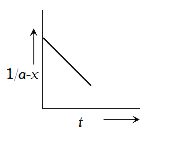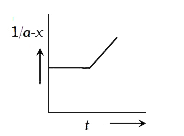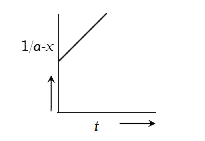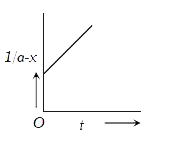For a reation: A→ Product,
rate law is −d[A]dt=K[A]0.
The concentration of A left after time t when t=1K is:




The correct Answer is:C
k=1t[1a−x−1a]
by rearranging the equation
kt=1a−x−1a
1a−x=kt+1a
by comparing with y=mx+c
slope =k, 1a= intercept.

Topper's Solved these Questions
- BOOK - ERRORLESSCHAPTER - CHEMICAL KINETICSEXERCISE - PAST YEARS QUESTIONS51videos
CHEMICAL KINETICS
- BOOK - ERRORLESSCHAPTER - CHEMICAL KINETICSEXERCISE - Assertion & Reason6videos
CHEMICAL KINETICS
- BOOK - ERRORLESSCHAPTER - CHEMICAL KINETICSEXERCISE - NCERT BASED QUESTIONS (Photochemical Reaction)4videos
CHEMICAL KINETICS
- BOOK - ERRORLESSCHAPTER - CARBOXYLIC ACIDSEXERCISE - Assertion & Reason5videos
CARBOXYLIC ACIDS
- BOOK - ERRORLESSCHAPTER - CHEMISTRY IN EVERYDAY LIFE EXERCISE - Assertion & Reason4videos
CHEMISTRY IN EVERYDAY LIFE
Similar Questions
The reaction A+OH−→ Products, obeys rate law expression as :
−d[A]dt=k[A][OH−]
If initial concentrations of [A] and [OH−] are 0.02 M and 0.3 M respectively and if it takes 30 sec for 1% A to react at 25∘C, caclutate the rate constant for the reactionView SolutionCalculate the rate of reaction from the following rate law:
−d[A]dt=k[A]1[B]2
when the concentrations of A and B are 0.01 M and 0.02 M respectively and k=5.1×10−3L2mol−2s−1.View Solution
Knowledge Check
- Question 1 - Select One
For a reation: A→ Product,
rate law is −d[A]dt=K[A]0.
The concentration of A left after time t when t=1K is:A[A]0eB[A]0×eC[A]0e2D1[A]0 - Question 2 - Select One
For a reaction 2A + B → product, rate law is −d[A]dt=k[A]. At a time when t=1k, concentration of the reactant is " (C0=initial concentration)
AC0eBC0eCC0e2D1C0 - Question 3 - Select One
For a hypothetical reaction: A+B→ Products, the rate law is r=k[A][B]0. The order of reaction is
A0B1C2D3

[A] = reactant concentration at time 't', k = rate constantView SolutionFor the reaction A B, the rate law expression is −d[A]dt=k[A]1/2. If initial concentration of [A] is [A]0, then
View SolutionFor the reaction : aA+bB→ Product
dxdt=k[A]a[B]b
If concentration of A is doubled, rate becomes four times. If concentration of B is made four times, rate becomes doubled . HenceView SolutionFor reaction, A → B, the rate law is rate = k[A]. If the reaction is 40.0% complete after 50.0 minutes, what is the value of the rate constant, k?
View SolutionFor a first order reaction −d[A]dt=K[A]0. The reaction is carried out by taking 100mol/litre of A, then concentration of A decayed after time 1K is:
View Solution

